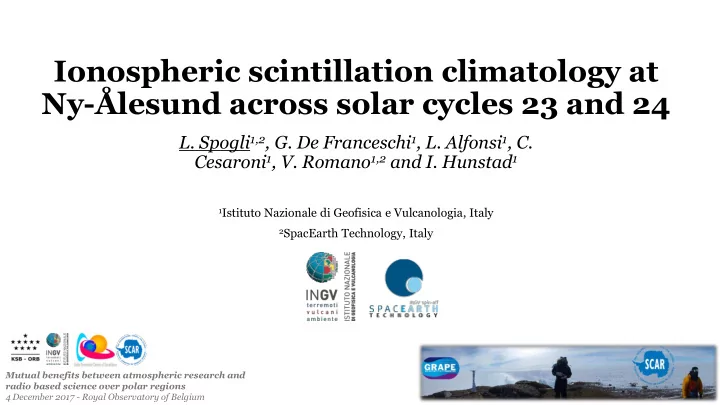

Ionospheric scintillation climatology at Ny-Ålesund across solar cycles 23 and 24 L. Spogli 1,2 , G. De Franceschi 1 , L. Alfonsi 1 , C. Cesaroni 1 , V. Romano 1,2 and I. Hunstad 1 1 Istituto Nazionale di Geofisica e Vulcanologia, Italy 2 SpacEarth Technology, Italy Mutual benefits between atmospheric research and radio based science over polar regions 4 December 2017 - Royal Observatory of Belgium
Summary Studying ionospheric irregularities with GNSS The Ny-Ålesund ionospheric station Overview scintillation climatology over more than 1 solar cycle Present and future status of the ionospheric studies at Ny-Ålesund Final remarks 4 December 2017 - Royal Observatory of Belgium Mutual benefits between atmospheric research and radio based science over polar regions
Studying ionospheric irregularities with GNSS 4 December 2017 - Royal Observatory of Belgium Mutual benefits between atmospheric research and radio based science over polar regions The formation of ionospheric irregularities at high latitudes is driven by the forcing from the geospace Scintillation : phase and Ionospheric irregularities, Fluctuations of the refractive index D n amplitude sudden fluctuations of i.e. the trans-ionospheric e.m. wave 𝑓 𝜇 2 ∆𝑜 ≈ − 𝑠 Fluctuations of ambient electron density D N 2𝜌 ∆𝑂 Reduced accuracy of positioning GNSS Loss of lock with the satellite HOW TO STUDY SCINTILLATION : Scintillation indices Radio signals carry memory of the ionosphere portion they cross. INGV contributed to the PolaRxS development in 50 Hz sampling the frame of CIGALA 1-min values project (funded by FP7, ended Jan 2012)
The Ny-Ålesund ionospheric station (Lat: 78.92° N, Mlat: 75.25° N ) Dirigibile Italia Station Disturbed conditions IQ = 6 Quiet conditions IQ = 0 GSV4004 scintillation data Holzworth, R. H. and Meng, C., 1975 since 9/2003 Feldstein, Y. I, 1963 PolaRxS data since The Ny-Ålesund ionospheric station is the perfect site to November 2015 study scintillations in the auroral/cusp/cap regions Data available in the INGV 4 December 2017 - Royal Observatory of Belgium Mutual benefits between atmospheric research ionospheric data repository: and radio based science over polar regions http://www.eswua.ingv.it www.spaceweather.it
Unprecedented scintillation climatology over more than 1 solar cycle Solar cycle 24 Solar cycle 23 4 December 2017 - Royal Observatory of Belgium Mutual benefits between atmospheric research and radio based science over polar regions GSV4004 scintillation data on GPS L1
Unprecedented scintillation climatology over more than 1 solar cycle Ground Based Scintillation Phase scint occurrence Amplitude scint occurrence ROT Mean & SD Climatology (GBSC) Spogli et al. (2009) Ann.Geophys. Alfonsi et al. (2011) Rad.Sci. Occurrence of phase and amplitude scintillation above the weak (0.1) and the moderate (0.25) thresholds 𝑃 % = 𝑂(𝑞 > 𝑈) 𝑃( s F ) ≫ 𝑃(S4) 𝑂 𝑢𝑝𝑢 Mean and Standard Deviation of the Rate of Total Electron Content change (ROT) 4 December 2017 - Royal Observatory of Belgium Climatological analysis is of support to understand which part Mutual benefits between atmospheric research and radio based science over polar regions of the ionosphere are more subject to signal degradation
Unprecedented climatology: dependence on IMF Statistical convection patterns sorted by IMF clock angle for 5 nT < BT < 10 nT. Color indicates the electric potential from SuperDarn measurements. Pettigrew, E. D. et al., 2010 4 December 2017 - Royal Observatory of Belgium Mutual benefits between atmospheric research and radio based science over polar regions
Unprecedented climatology: dependence on auroral activity AU |AU|,|AL| > 400 nT AL |AU|,|AL| < 400 nT 4 December 2017 - Royal Observatory of Belgium Mutual benefits between atmospheric research and radio based science over polar regions
Unprecedented climatology: dependence on geomagnetic disturbance level 4 December 2017 - Royal Observatory of Belgium Mutual benefits between atmospheric research and radio based science over polar regions
Present and future status of the ionospheric studies at Ny-Ålesund s F >0.1 New PolaRxS receiver installed in 2015 Multiconstellation capabilities Year 2016 data (GPS+GLONASS+ GALILEO ) Data available in the new eSWua website Galileo 4 December 2017 - Royal Observatory of Belgium s F >0.1 Mutual benefits between atmospheric research and radio based science over polar regions GPS
Remarks First climatology of the L-band scintillation occurrence over more than one solar cycle Magnetic Noon and pre-midnight sectors are the hot spots for the formation of scintillation- effective irregularities Fragmentation of the tongue of ionization in the cusp/cleft and cap regions Configuration of the statistical patterns of convection cells sorted according to the IMF Bz/By conditions Sorting according to the AU/AL conditions allows identifying the role of the inflow/outflow of plasma from/to the plasmasphere The PolaRxS receiver installed in 2016 extends the capability of the Ny-Ålesund station through the inclusion of the GALILEO information Climatological analysis is then of support to understand which part of the ionosphere are more subject to signal degradation Help for modelling and climatological forecasting in support of accounting for the ionospheric impact in atmospheric sciences and applications
luca.spogli@ingv.it
Recommend
More recommend